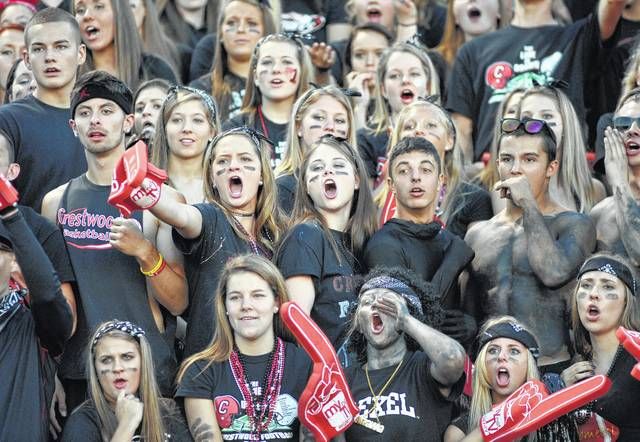Click here to subscribe today or Login.
The PIAA Board of Directors decided Wednesday to allow individual schools to determine how many spectators are allowed at sporting events.
“We’re trying to ask schools to make their own individualize assessment and decision based on their legal advice and the decision making of their board,” PIAA executive director Robert Lombardi said.
The board didn’t vote on the issue, but made the decision after getting advice from attorney Alan Boynton, its legal counsel, and Andy Goodman, its legislative representative.
“So our message to the schools is it’s up to you,” said District 2 chairman and PIAA board president Frank Majikes.
The decision came about an hour after House Bill 2787, which would allow individual schools to determine rules on spectators during the COVID-19 pandemic, failed to get the two-thirds majority in the House of Representatives to override a veto by Gov. Tom Wolf.
The House passed the bill 155-47 and the State Senate did the same by a 39-11 vote on Sept. 9. Wolf used the maximum 10 days allowed before he vetoed it. The House then had 25 members flip their votes, causing the bill to fall short of the requirement for an override to send it to the Senate.
Boynton said because Wolf’s gathering limits of 25 indoors and 250 outdoors were ruled unconstitutional by a federal judge that schools can determine attendance at sporting events. Wolf lost an appeal to the ruling but has another appeal pending. Boynton said he expects that appeal will be ruled on next week.
“At this point, yes, there is no limitation on (spectators),” said Boynton, who cautioned that if Wolf wins the stay of his original spectator limits, then they would return to 25 indoors and 250 outdoors.
The 25 and 250 numbers include players, coaches, game officials, cheerleaders and band where applicable, media and any other game-day personnel needed to conduct the sporting event.
District 3 representative Doug Bohannon asked for some clarification. While some schools have been sticking to the 25 and 250 limits, others have been allowing in more spectators after Wolf’s limitations were ruled unconstitutional.
“What Alan said was right,” Goodman said. “At this time, because of the stay (of the judge’s ruling) is outstanding, the local schools can decide at this point. Now, that may change with the court cases that proceed.”
District 7 chairman Scott Seltzer suggested the PIAA tell the schools to work with their solicitors to determine attendance at events.
“I don’t know if we want to go out and start making legal opinions as an athletic organization,” Seltzer said. “Also, I think you have to take into account if you have a county health department what regulations fall on you because, if I’m not mistaken, the actual court ruling did not say anything about any county limitations or restrictions. It was strictly on the governor. I think those things need to be followed as well.”
Lombardi said the PIAA tried to work with the Wolf administration to get spectator limits increased to 25% of a facility’s capacity, but the effort has made little progress. He added with girls volleyball that substitute players have been sequestered in hallways or wrestling rooms before they entered the match.
“We feel pretty strongly for (schools) to have families … there, especially in a supervisory capacity,” Lombardi said, “because we’ve already heard stories of young people getting hurt and they have to get on the phone and call somebody. We don’t think that’s a healthy situation.”
The next board meeting is scheduled for Oct. 7.
The board also tackled other issues during its meeting of over two hours.
• Suspended protocol and voted 29-0 to allow individual districts to determine postseason qualifiers regardless of the number of games played. PIAA bylaws state that a team must play at least 50% of its games scheduled in the regular season. The exception to the bylaws is only for fall sports this year.
• Eliminated the deadline for the regular season on a first reading with a 29-0 vote. If a team in any sport qualifies for the postseason and is eliminated or a team fails to make the postseason, it can still play regular-season games as long as it doesn’t exceed the maximum number of games allowed by the PIAA and finishes before the sport’s state championship game.
The motion either has to pass two more readings or the board could suspend protocol at the October meeting and hold a final vote.
• Tabled with a 29-0 vote a motion that would allow schools which have their fall seasons end due to COVID-19 to be allowed to participate in those sports in the spring. The major stumbling block was the percentage of games that were played in the fall before a team could then play in the spring.
District 1 chairman Mike Barber, whose district had about half of its 93 schools suspend fall sports, wanted the number at 40%, but was willing to go to 30%. Lombardi said he was more comfortable with 20-25%.
No matter what transpires, no team could play more than the maximum number of games allowed by the PIAA. For example, a football team which played only two games in the fall couldn’t play more than eight in the spring.
• Voted 28-0 with one abstention to allow schools that suspended fall sports to participate in them in the spring. These teams would not have playoffs.
District 1 and District 12 had a majority of their schools shut down fall sports. Lombardi said it would work with its districts to come up with an alternative fall schedule which would likely run from March to April between the winter and spring sports seasons.
• Brackets for all fall sports championships were approved. The board had two sets to choose from in all sports. The official brackets will be posted at piaa.org possibly as early as Thursday.





